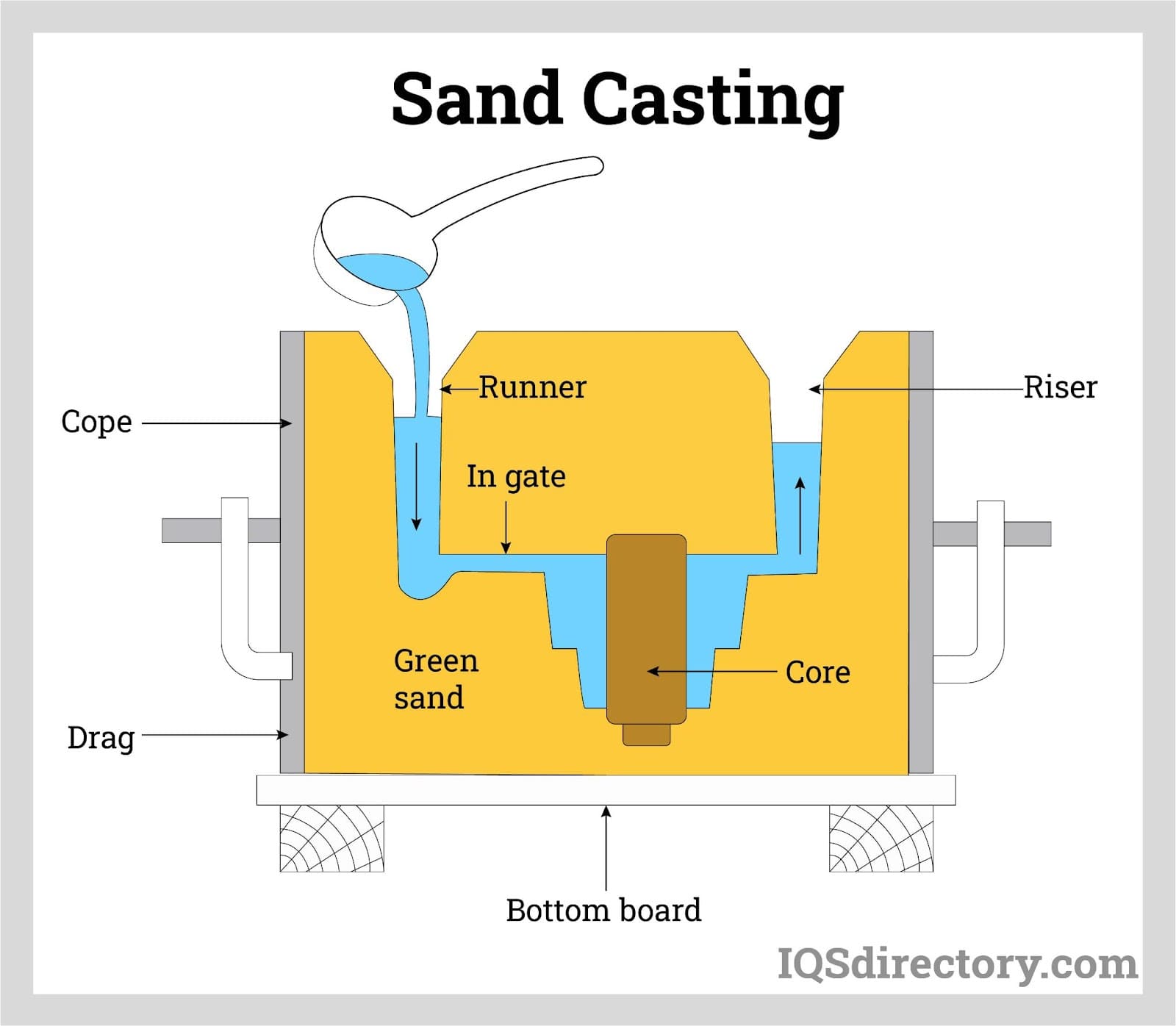Ways Aluminum Foundry Wisconsin strengthens casting businesses
Wiki Article
How Aluminum Foundry Adds To Innovations in Aerospace Design
Aluminum factories are integral to innovations in aerospace engineering. They generate lightweight, high-strength components that are necessary for modern airplane. Through innovative casting methods, these shops produce intricate geometries that enhance architectural stability. Furthermore, the growth of exceptional Aluminum alloys supports the sector's concentrate on gas effectiveness and sustainability. However, challenges continue to be in the production process. Comprehending these aspects discloses the profound effect of Aluminum on aeronautics's future.The Importance of Lightweight Products in Aerospace Layout
As the aerospace industry remains to evolve, the significance of light-weight products comes to be progressively noticeable. The demand for efficiency and sustainability drives designers to prioritize the use of materials that reduce general weight without endangering structural honesty. Lightweight products, especially Aluminum, play a vital function in enhancing gas performance, enhancing haul ability, and increasing the total performance of airplane.Moreover, the integration of these products permits innovative designs, making it possible for suppliers to produce even more aerodynamic shapes that can hold up against severe problems. The decrease in weight not only lowers operational prices however additionally adds to a reduced environmental impact, straightening with global efforts toward sustainability in air travel.
Advanced Spreading Techniques in Aluminum Foundries
Advanced casting strategies in Aluminum foundries play an essential function in aerospace engineering by making it possible for the production of light-weight and exact parts. Innovations in mold and mildew layout and precision casting procedures are vital in accomplishing ideal efficiency and architectural honesty. In addition, the development of light-weight alloys boosts the overall performance and effectiveness of aerospace applications.Innovative Mold Layout
Innovative mold design plays an important function in the efficiency and performance of Aluminum factories, especially within the aerospace field. By leveraging innovative materials and strategies, modern mold and mildews can be crafted to stand up to high temperature levels and pressures, making certain peak performance throughout the casting procedure. These layouts commonly include intricate geometries that permit the manufacturing of light-weight yet structurally sound parts, necessary for aerospace applications. Furthermore, using computer-aided design (CAD) software program promotes accurate modeling, enabling factories to simulate and improve mold designs before physical production begins. This not just enhances the quality of cast components yet also minimizes waste and lead times, resulting in considerable expense savings. Generally, cutting-edge mold design is a foundation of progression in Aluminum Foundry modern technology for aerospace engineering.Precision Casting Procedures
The effectiveness of cutting-edge mold styles effortlessly integrates with accuracy spreading procedures, which are crucial for producing top quality Aluminum elements in aerospace engineering. These processes, consisting of sand spreading, die spreading, and investment casting, ensure the development of complex geometries with limited resistances. Advanced strategies like vacuum cleaner casting and pressure die casting improve the integrity and surface area coating of the last items. Precision spreading minimizes material waste while taking full advantage of the mechanical buildings of Aluminum, vital for aerospace applications. Additionally, utilizing real-time tracking and advanced simulation tools throughout the casting procedure permits immediate adjustments, causing improved top quality control. Collectively, these precision casting procedures setting Aluminum factories at the leading edge of aerospace innovation, supporting the market's need for reliability and performance.Lightweight Alloy Growth
As aerospace designers seek to boost gas efficiency and efficiency, light-weight alloy growth becomes a necessary emphasis in Aluminum factories. These foundries employ innovative spreading techniques to create alloys that give superior strength-to-weight proportions. Advancements in alloy composition, consisting of the unification of aspects like lithium and magnesium, allow the production of materials that hold up against severe problems while lowering overall airplane weight. Methods such as die casting and financial investment casting help with the accuracy manufacturing of complex forms, which are essential for aerospace applications. Additionally, recurring research aims to enhance these alloys for improved mechanical residential or commercial properties and increased durability. By prioritizing lightweight alloy advancement, Aluminum shops considerably add to the evolution of aerospace design, leading the way for much more effective and lasting airplane styles.
Enhancing Structural Integrity Via Aluminum Parts
Aluminum elements offer considerable benefits in enhancing structural honesty within aerospace design. Their lightweight nature adds to total efficiency while preserving toughness, which is vital for airplane performance. Additionally, the tension resistance residential or commercial properties of Aluminum help ensure the sturdiness and integrity of aerospace frameworks under numerous operational problems.
Lightweight Material Benefits
While traditional products typically endanger weight for strength, using Aluminum parts in aerospace design offers substantial benefits in structural honesty. Aluminum's light-weight nature adds to overall design performance, enabling even more streamlined aircraft that take in less fuel, therefore boosting sustainability. The product's outstanding strength-to-weight ratio assurances that elements maintain toughness without adding unnecessary mass. This top quality fosters enhanced performance and agility in trip, in addition to optimized haul capabilities. In addition, Aluminum's resistance to deterioration prolongs the life-span of aerospace frameworks, minimizing upkeep expenses and enhancing safety. As makers progressively adopt Aluminum alloys, the aerospace industry experiences a transformative change towards more efficient and reliable engineering remedies that focus on both performance and environmental duty.Stress And Anxiety Resistance Characteristics
Although numerous materials possess one-of-a-kind buildings, Aluminum's outstanding tension resistance stands out as an essential variable in boosting the structural stability of aerospace elements. This resistance plays a critical function in making certain that airplane can stand up to numerous operational anxieties, including tiredness, effect, and environmental problems. Aluminum alloys, especially crafted for aerospace applications, show high tensile strength while preserving light-weight qualities, allowing designers to make more effective structures - Aluminum Foundry. In addition, the ability of Aluminum to sustain cyclic loading without considerable contortion adds to the longevity and reliability of aerospace elements. As improvements continue in Aluminum Foundry techniques, the development of stress-resistant Aluminum parts promises more enhancements in performance, security, and efficiency across the aerospace industry, solidifying Aluminum's duty as a preferred material in modern engineeringFuel Efficiency Improvements Driven by Aluminum Innovations
As the aerospace market looks for to enhance gas efficiency, ingenious uses Aluminum have arised as an essential solution. Aluminum's light-weight nature notably lowers aircraft weight, enabling reduced fuel consumption throughout flight. This reduction in weight is important, as even little reductions can lead to substantial renovations in overall gas economic climate.Advanced Aluminum alloys, made for boosted toughness and durability, enable makers to create elements that maintain architectural honesty while reducing mass - Aluminum Foundry. Additionally, the assimilation of Aluminum in airframes and engine parts helps with enhanced aerodynamics, adding to minimized drag and raised effectiveness
The adoption of Aluminum in aerospace not just meets the need for fuel-efficient design but additionally aligns with governing stress for reduced discharges. As these technologies proceed to develop, they play a considerable function in setting brand-new criteria for gas efficiency, making sure that the aerospace industry can satisfy expanding financial and environmental obstacles.

The Function of Aluminum in Sustainable Air Travel Practices
The enhancing focus on lasting air travel practices has actually positioned Aluminum as a vital material in the mission for greener airplane design. Known for its light-weight properties, Aluminum significantly decreases airplane weight, bring about reduced gas intake and discharges. Its recyclability additionally boosts its sustainability account, as Aluminum can be reused forever without loss of quality. This characteristic supports a circular economic climate within the aeronautics market, lessening waste and source deficiency.In addition, developments in Aluminum alloys have actually improved their strength and rust resistance, enabling blog longer life span and reduced upkeep requirements. These innovations facilitate the growth of extra effective aircraft structures, contributing to total sustainability efforts. Furthermore, Aluminum's thermal conductivity plays a crucial role in energy-efficient layouts, boosting systems such as heat exchangers. Collectively, these qualities highlight Aluminum's pivotal duty beforehand lasting aeronautics, aligning with international campaigns focused on minimizing the environmental impact of flight.
Challenges Encountered by Aluminum Foundries in Aerospace Production
While Aluminum foundries play an essential role in aerospace manufacturing, they encounter considerable obstacles that can influence production effectiveness and top quality. One significant difficulty is the strict high quality control criteria called for in the aerospace industry. Any kind of flaw can compromise security and performance, necessitating extensive evaluation procedures that extend his comment is here production timelines. Additionally, factories typically compete with rising and fall basic material expenses, which can affect rates and success. The complexity of Aluminum alloys used in aerospace applications additional makes complex the production procedure, as precise formulas are critical for accomplishing desired mechanical buildings. Moreover, proficient labor scarcities hinder the ability to preserve high-quality production levels. Finally, environmental laws enforce limitations on emissions and waste management, needing shops to buy sustainable techniques, which can be cost-prohibitive. These variables collectively create a landscape where Aluminum shops must continually adapt to fulfill the evolving demands of aerospace manufacturing while guaranteeing safety and conformity.Future Fads in Aluminum Applications for Aerospace Design
With innovations in modern technology and increasing demands for effectiveness, the future of Aluminum applications in aerospace design is poised for considerable transformation. The combination of ingenious Aluminum alloys and compounds is expected to enhance strength-to-weight ratios, resulting in even more fuel-efficient airplane layouts. Additionally, improvements in additive manufacturing strategies will permit the production of complicated Aluminum frameworks that were formerly difficult, maximizing efficiency and reducing waste.
Lasting methods will certainly play an important function, with a growing emphasis on reusing Aluminum to reduce environmental influence. The aerospace field is likely to welcome smarter manufacturing processes, such as automation and expert system, making certain higher top quality and precision in Aluminum components. Moreover, cooperations in between Aluminum factories and aerospace firms will certainly foster research study and advancement, paving the method for brand-new applications that meet the strict requirements of modern-day aerospace design - Aluminum Foundry. In general, the future looks assuring for Aluminum's function fit the skies
Regularly Asked Questions
What Are the Environmental Impacts of Aluminum Manufacturing in Aerospace?
The ecological impacts of Aluminum manufacturing in aerospace consist of significant energy intake, greenhouse gas discharges, and habitat disruption. In addition, mining procedures can cause soil destruction and water contamination, increasing worries concerning sustainability and ecological balance.Just How Does Aluminum Compare to Various Other Products in Aerospace Applications?
Aluminum provides a special mix of lightweight buildings, rust resistance, and cost-effectiveness contrasted to various other materials. Its high strength-to-weight proportion makes it especially useful for aerospace applications, boosting gas efficiency and total performance in aircraft layout.What Qualifications Do Aluminum Foundry Workers Need for Aerospace Projects?
Aluminum Foundry employees require specific training in metallurgy and casting methods, along with expertise of aerospace market requirements. Accreditations in quality control and safety and security procedures are also necessary to guarantee conformity with stringent aerospace task requirements.Are There Any Safety Worry About Making Use Of Aluminum in Aerospace Engineering?
Safety and security concerns regarding Aluminum in aerospace engineering consist of susceptibility to anxiety, rust, and fatigue fractures. Appropriate therapy and alloy choice are important to minimize these dangers, making sure architectural stability and overall safety in aerospace applications.this article
How Does Aluminum Recycling Benefit the Aerospace Market?
Aluminum reusing greatly benefits the aerospace sector by reducing product expenses, lessening environmental impact, and preserving power. This sustainable practice enhances the market's performance while advertising the use of light-weight, high-performance components in airplane production.Advanced spreading methods in Aluminum shops play a critical function in aerospace engineering by making it possible for the production of exact and light-weight components. Ingenious mold and mildew design plays an essential duty in the efficiency and efficiency of Aluminum factories, especially within the aerospace field. As aerospace engineers seek to enhance gas performance and performance, lightweight alloy growth ends up being a crucial focus in Aluminum foundries. Aluminum alloys, specifically crafted for aerospace applications, display high tensile strength while maintaining light-weight features, allowing engineers to design more reliable structures. Collaborations in between Aluminum shops and aerospace firms will cultivate research and development, paving the method for new applications that satisfy the rigorous requirements of modern-day aerospace design.
Report this wiki page